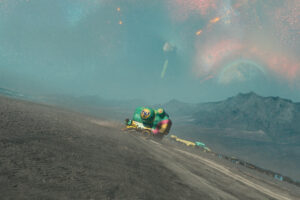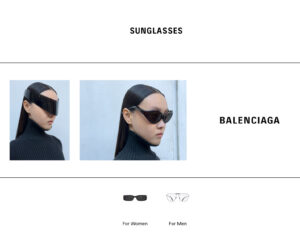
In the world of visual storytelling, concept artists are often the unsung architects—sculpting light, mood, and terrain long before cameras roll or pixels lock into place. Few embody this foundational yet invisible labor with as much fervor as George Varodi, whose recent contribution to the cinematic short for Marathon—a reimagined sci-fi world rooted in Bungie’s legacy—marks a defining point in the continuum of narrative design.
As a concept artist and visual development specialist, Varodi has long operated at the intersection of creative speculation and rigorous execution. But with Marathon, the stakes were different. Here, he wasn’t merely illustrating someone else’s vision—he was shaping the visual grammar of an entire world. Under the directorial command of Alberto Mielgo and the production umbrella of Pinkman.tv, in mixture with Bungie, Illusorium Studios, and Agora Studio, Marathon was less a gig than a gauntlet: a test of invention, intuition, and trust.
The Legacy of Marathon: A Myth Revisited
For those steeped in gaming history, Marathon is more than a title—it’s a relic. First released in 1994 by Bungie, Marathon predates the studio’s world-conquering Halo franchise, yet shares its genetic code: stark science fiction, existential dread, and mythic architecture. In reviving the title in 2025 as a narrative-driven short and expanded universe, Bungie has chosen not to replicate the past, but to reimagine it with cinematic sophistication.
Enter George Varodi. A veteran of concept design across interactive and linear mediums, Varodi was tasked not just with building environments, but with reinterpreting a world once confined to pixelated corridors and low-poly AI chatter. His challenge was both technical and philosophical: how do you render the ghost of a game, without losing its soul?
The Animatic: Tempo, Tension, and Trust
In the early stages of the production, Varodi collaborated closely with director Alberto Mielgo to shape the animatic—a preliminary visualization of the short film. Known for his painterly aesthetic and kinetic storytelling, Mielgo (whose past credits include The Windshield Wiper and Love, Death + Robots) brings an auteurist intensity to every frame. For Varodi, this meant a demanding but liberating partnership.
“Real creative trust,” Varodi describes it. “That’s rare. But it also means you have to deliver—to match that trust with total precision.” Animatics are often underestimated, dismissed as technical stepping stones. But in a project as visually rich as Marathon, the animatic was sacred: a space where every pan, cut, and lighting cue could be tested before being executed in full fidelity.
Varodi’s early boards weren’t mere placeholders—they were emotional drafts. He sculpted silence, pause, and propulsion into his frames. Each storyboard panel was infused with spatial logic, psychological undercurrent, and environmental tension. “You don’t just draw what’s happening,” he explains. “You draw what it feels like to happen in that space.”
Worldbuilding at Scale: Atmosphere as Character
Perhaps the most enduring contribution from Varodi lies in the final environmental look of Marathon. The film’s world isn’t merely backdrop—it is an active, breathing entity. Evocative of derelict futurism, it fuses the ruin-porn of abandoned space stations with the seductive haze of post-human elegance. Think brutalist megastructures overgrown with synthetic moss, corridors littered with technological ghosts, and light shafts that seem to mourn their own clarity.
Drawing from a mixture of photobash techniques, hand-painted layers, and 3D blocking, Varodi helped create environments that feel ancient and near, vast yet claustrophobic. His sense of color—restrained, industrial, and tinted with radioactive melancholy—serves as a connective tissue between narrative beats.
Collaboration with Illusorium Studios and Agora Studio was essential in realizing the final renderings. But Varodi’s environments began as psychological blueprints. “You’re designing trauma,” he says. “Not just a place, but the memory of what that place endured. It’s haunted design.”
Technical Fluidity and the Artist’s Eye
Varodi’s process resists monolithic definition. Part of a new wave of hybrid artists, he blends analog sensibility with digital dexterity. In the case of Marathon, he moved between software suites—Photoshop for textural nuance, Blender for geometric layout, and proprietary Bungie tools for pipeline compatibility.
“Visual development is choreography,” he notes. “You’re not just painting—you’re synchronizing color, form, and motion in anticipation of animation, lighting, and performance capture.” In other words, you’re building the house and staging the play at the same time.
This dual consciousness—of form and function, fantasy and feasibility—is what separates a competent concept artist from a world-class one. In Marathon, we see Varodi’s ability to not only imagine but to anticipate: to know what an environment will feel like once it’s in motion, lit, scored, and inhabited.
Visual Development in 2025: A Field Transformed
To situate Varodi’s contribution within the wider arc of 2025 is to observe a field in flux. The role of concept artist has mutated over the past decade—partly due to advances in real-time rendering, partly because of the collapse of boundaries between cinematic and game pipelines. The once-linear progression from concept to final shot has become a recursive, multi-branching organism.
With the rise of virtual production, concept artists are often feeding directly into live render engines. What was once “pre-production” is now “constant production.” As such, visual dev artists like Varodi are increasingly expected to be visual strategists—deeply embedded in narrative, physics, lighting, and interactive design.
Moreover, the explosion of AI tools has disrupted workflows. While Varodi remains deeply manual in his craft, he acknowledges the presence of AI as both threat and tool. “It can help you brainstorm,” he admits, “but it can’t replace vision. It has no memory. No trauma. No impulse.” For now, the human hand—imperfect, intuitive, obsessive—remains central.
The Emotional Architecture of Sci-Fi
What Marathon achieves, in no small part due to Varodi’s worldbuilding, is emotional clarity through abstraction. The environments evoke dread without gimmick, awe without spectacle. They feel inhabited by story, not merely by characters.
This approach runs counter to much contemporary sci-fi, which often leans on maximalism or exposition-heavy design. Varodi’s sensibility, honed across years of quietly influential work, leans instead toward restraint. He allows silence to function as architecture, negative space to act as narrative.
In this way, he is aligned with the likes of Ralph McQuarrie, Syd Mead, and more recently, the late Moebius. But while those legends defined the analog age, Varodi’s contribution is digital at the bones—but analog in its soul.
Flow
When George Varodi describes the Marathon project as “a rare thing,” what he means is not just the difficulty of the work, but the clarity of its purpose. Under Mielgo’s directorial compass and within the ecosystem of Pinkman.tv and Bungie, the production summoned the kind of artistic rigor and coherence that many larger productions struggle to attain.
It is rare to find a concept artist who speaks with as much emphasis on feeling as on frame rate. But this is the duality that defines Varodi: part technician, part visual poet. In the final frames of Marathon, one can see not just the shimmer of a distant world, but the fingerprint of a meticulous architect—a man who drew not what he saw, but what he sensed beneath the surfaces.
No comments yet.








